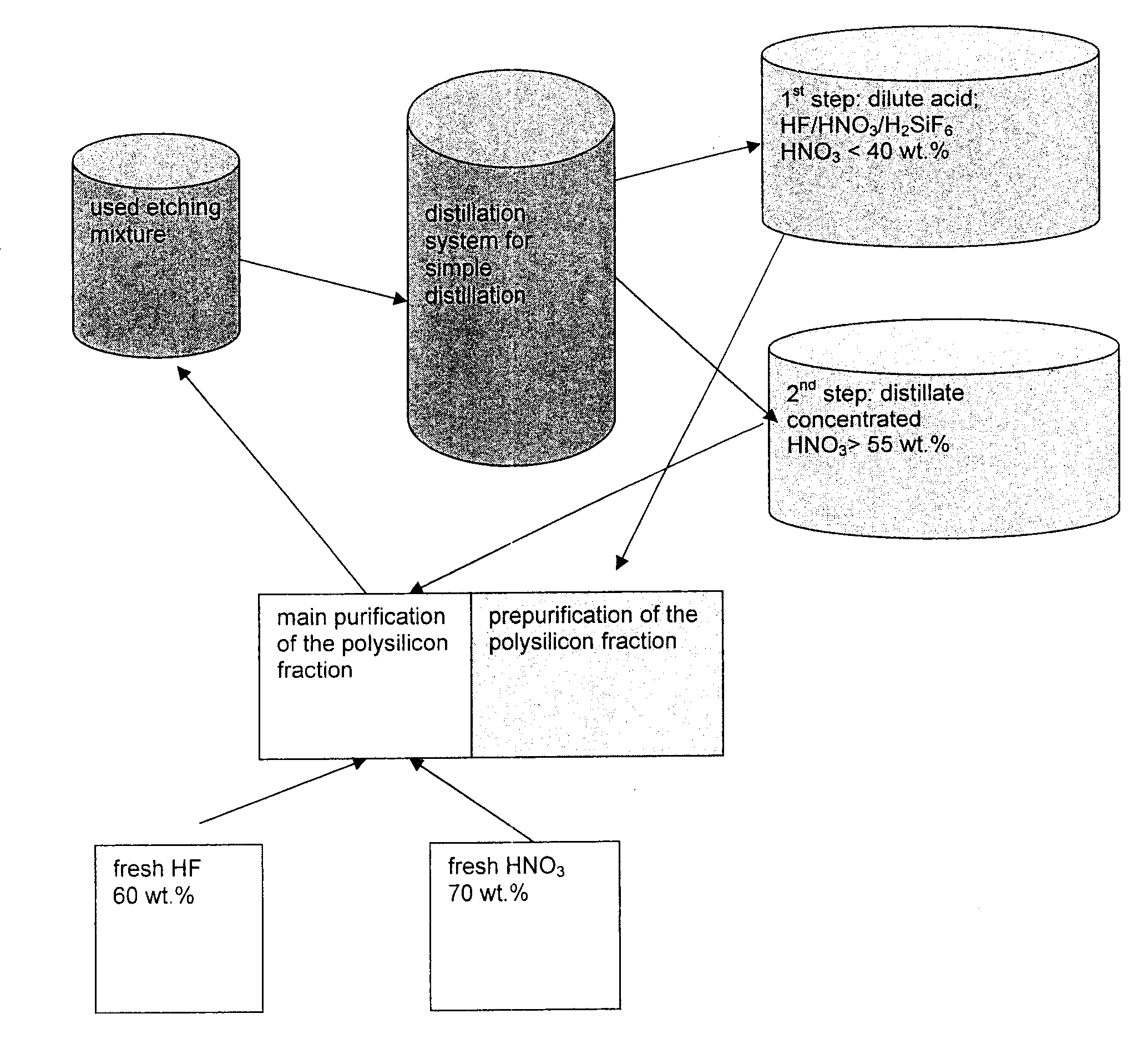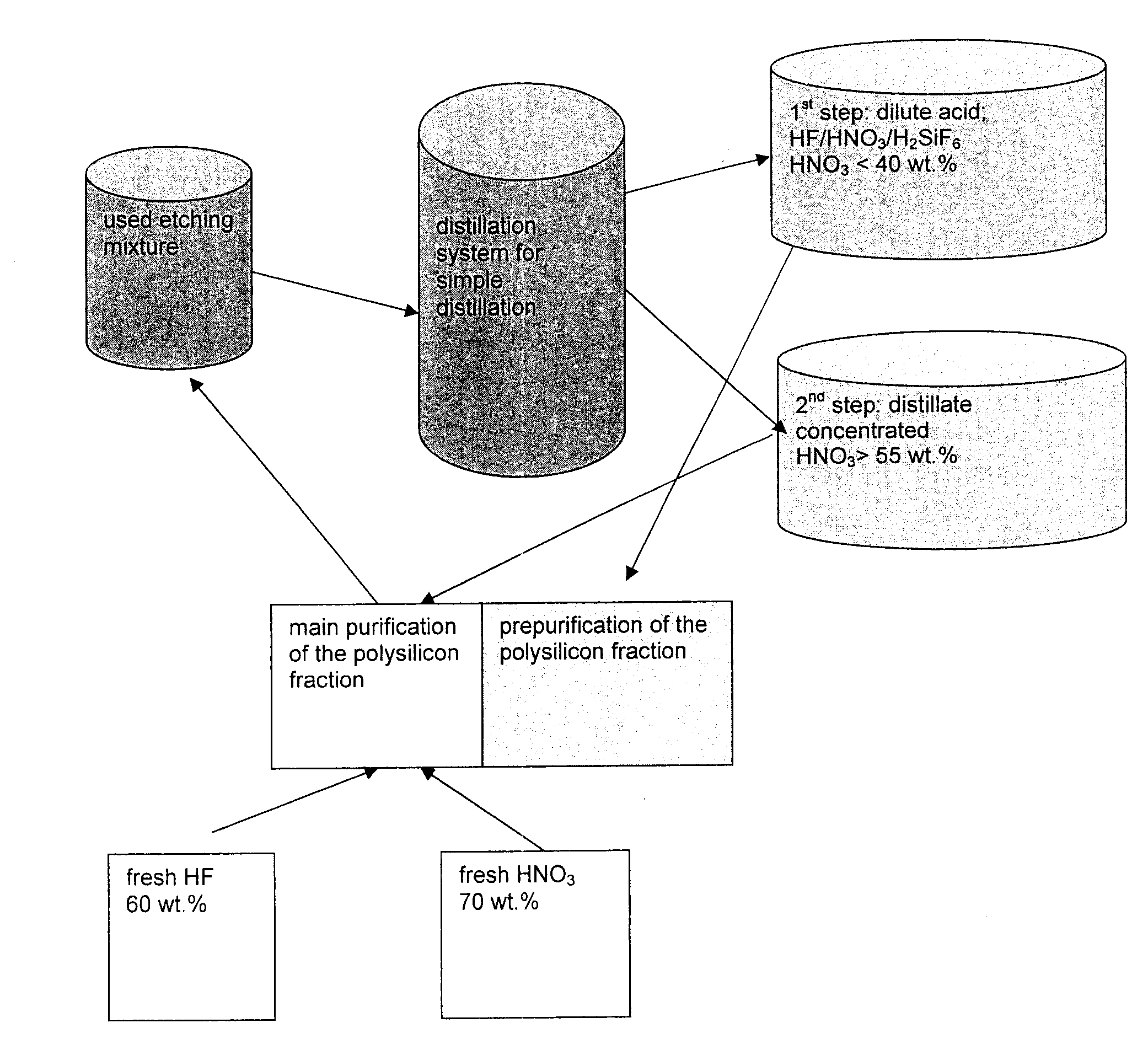Method for processing an etching mixture which is formed during the production of highly pure silicon
a technology of etching mixture and etching mixture, which is applied in the direction of silicon compounds, separation processes, refrigeration components, etc., can solve the problems of uneconomical and too expensive methods, and achieve the effect of simple cost-effectiveness
- Summary
- Abstract
- Description
- Claims
- Application Information
AI Technical Summary
Benefits of technology
Problems solved by technology
Method used
Image
Examples
example 1
[0020]600 ml of a used etching mixture from the purification of crystalline polysilicon, containing 6 wt. % HF, 45 wt. % HNO3, 12 wt. % H2SiF6 and 0.5 wt. % HNO2, were heated and distilled in a closed distillation apparatus. For this distillation, the used etching mixture was placed in a teflon flask and heated therein to about 120° C. by means of a heating mantle with a heating power of 300 W. 5 minutes after the start of heating, the liquid began to boil. After a further 60 minutes, 250 ml of dilute acid had condensed in a collection container. 350 ml remained in the flask bottom. The composition of the two fractions was determined with the aid of the DET method described in DE 198 52 242 A1:
[0021]
Bottom product:nitric acid59.8wt. %hydrofluoric acid3.0%wt. %silicon0.1%wt. %H2O37.1%wt. %Dilute acid:nitric acid39.0wt. %hydrofluoric acid6.9wt. %silicon1.4wt. %H2O52.7wt. %
[0022]The analyses of the acids carried out by the DET method in order to determine the acid concentrations showed...
example 2
[0026]As described in Ex. 1, 100 l of fraction 1 (dilute acid) and 500 l of fraction 2 were produced. Fraction 2 with the more highly concentrated acid obtained in the second step at a temperature of from 100 to 180° C. was collected in a collection container. From this collection container, the mixture was added to the etching mixture for the main purification of the polysilicon fraction. In order to maintain the bath concentration of 56 wt. % HNO3 and 6 wt. % HF in the etching bath, fresh highly concentrated acids of electronics quality with a content of 60 wt. % HF and 70 wt. % HNO3 were also added. By supplying the distillate, the amount of fresh 60 wt. % hydrofluoric acid and 70 wt. % nitric acid are reduced by 60 wt. %. A poly batch purified by means of such an etching solution does not differ in its purity from a poly batch which was produced exclusively by means of a new etching solution.
example 3
[0027]As described in Ex. 1, 100 l of fraction 1 (dilute acid) and 500 l of fraction 2 were produced. The dilute acid obtained in the second step at a temperature of from 110 to 200° C. with a composition of 35 wt. % HNO3, 6.9 wt. % HF and 1.4 wt. % Si is added to the acid cycle of the purification of polycrystalline silicon. Topping up with highly concentrated 60 wt. % hydrofluoric acid and 70 wt. %, as described in Example 2, is not necessary here since an HF / HNO3 mixture with this concentration attacks silicon only slightly and HF and nitric acid do not therefore become consumed. A poly batch which is prepurified with such an etching solution does not differ from a poly batch which was produced exclusively by means of a fresh etching solution.
PUM
| Property | Measurement | Unit |
|---|---|---|
| temperature | aaaaa | aaaaa |
| temperature | aaaaa | aaaaa |
| temperature | aaaaa | aaaaa |
Abstract
Description
Claims
Application Information
 Login to View More
Login to View More - R&D
- Intellectual Property
- Life Sciences
- Materials
- Tech Scout
- Unparalleled Data Quality
- Higher Quality Content
- 60% Fewer Hallucinations
Browse by: Latest US Patents, China's latest patents, Technical Efficacy Thesaurus, Application Domain, Technology Topic, Popular Technical Reports.
© 2025 PatSnap. All rights reserved.Legal|Privacy policy|Modern Slavery Act Transparency Statement|Sitemap|About US| Contact US: help@patsnap.com


